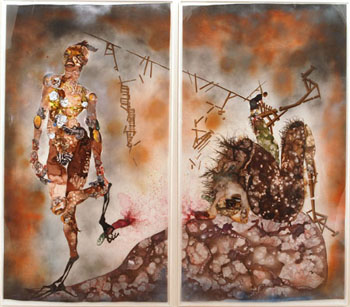pankaj mishra on pakistan: “The Obama administration should consider the possibility that, as Graham Fuller, the CIA’s former station chief in Kabul puts it, few Pashtuns “will long maintain a radical and international jihadi perspective once the incitement of the US presence is gone.” Full article.
screening of “awaiting for men” on june 18th
RCTV organizes a free film festival every year. this year, it includes an interesting film about muslim women in mauritania – a very different take on muslim countries and cultures. the film is called “awaiting for men” and it will be screened thursday, june 18 at 7.30pm, at the RCTV studios, 21 gorham street, rochester (off of st paul st). i will be leading a discussion after the screening. more information.
Police clash with Indians in Peru
A non violent movement turns violent when the Peru govt cracks down on protesters. Dozens of people have been killed in clashes between indigenous people and police in Peru. The Indians have been protesting against laws which will open up communal jungle lands and water resources to oil drilling, logging and mining.
Neo-Nazis are in the Army now
steven green, who was responsible for the mahmudiyah killings and the rape and murder of a 13 year old iraqi girl, also received a moral character waiver for prior drug and alcohol related offenses that might have otherwise disqualified him from joining the u.s. army. neo nazis in iraq and afghanistan – how is that going to play out?
Read “Neo-Nazis are in the Army now” by By Matt Kennard.
“Iran’s Election: None of America’s Business” by Justin Raimondo
“Is the U.S. involved in the current street fighting in Tehran and other major cities? I wouldn’t be at all surprised to have this suspicion confirmed in coming days. After all, in 2007 Congress appropriated $400 million to destabilize the Iranian regime, and who’s to say this program isn’t bearing fruit?” Full article.
US Drone Strike in South Waziristan Kills at Least Five
“A US drone struck three vehicles in Pakistan’s South Waziristan Agency today, killing at least five people. It was unclear who was slain in the attack. It was the first US drone strike into Pakistan in nearly a month.” Full article.
“Destroying Pakistan to Make It Safe” by Eric Margolis
“The real danger is in the US acting like an enraged mastodon, trampling Pakistan under foot, and forcing Islamabad’s military to make war on its own people. Pakistan could end up like US-occupied Iraq, split into three parts and helpless.” Full article.
dinner and conversation
ice bowl with garden flowers created by my friend shahin to serve pistachio ice cream. dinner at our house. 12 people. musicians, artists, bloggers, activists, academics and yes, even a doctor and a lawyer.


“Wishful thinking from Tehran” by Abbas Barzegar
“For over a week the same social impulses of anti-corruption, populism, and religious piety that led to the revolution have been on the streets available to anyone who wanted to report on them. Ahmedinejad, for most in the country, embodies those ideals.” Full article.
“Stealing the Iranian Election” by Juan Cole
” It is claimed that Ahmadinejad won the city of Tabriz with 57%. His main opponent, Mir Hossein Mousavi, is an Azeri from Azerbaijan province, of which Tabriz is the capital. Mousavi, according to such polls as exist in Iran and widespread anecdotal evidence, did better in cities and is popular in Azerbaijan. Certainly, his rallies there were very well attended. So for an Azeri urban center to go so heavily for Ahmadinejad just makes no sense. In past elections, Azeris voted disproportionately for even minor presidential candidates who hailed from that province.” Full article.
“The Man-Moth” by Elizabeth Bishop
Here, above,
cracks in the buildings are filled with battered moonlight.
The whole shadow of Man is only as big as his hat.
It lies at his feet like a circle for a doll to stand on,
and he makes an inverted pin, the point magnetized to the moon.
He does not see the moon; he observes only her vast properties,
feeling the queer light on his hands, neither warm nor cold,
of a temperature impossible to record in thermometers.
But when the Man-Moth
pays his rare, although occasional, visits to the surface,
the moon looks rather different to him. He emerges
from an opening under the edge of one of the sidewalks
and nervously begins to scale the faces of the buildings.
He thinks the moon is a small hole at the top of the sky,
proving the sky quite useless for protection.
He trembles, but must investigate as high as he can climb.
Up the façades,
his shadow dragging like a photographer’s cloth behind him
he climbs fearfully, thinking that this time he will manage
to push his small head through that round clean opening
and be forced through, as from a tube, in black scrolls on the light.
(Man, standing below him, has no such illusions.)
But what the Man-Moth fears most he must do, although
he fails, of course, and falls back scared but quite unhurt.
Then he returns
to the pale subways of cement he calls his home. He flits,
he flutters, and cannot get aboard the silent trains
fast enough to suit him. The doors close swiftly.
The Man-Moth always seats himself facing the wrong way
and the train starts at once at its full, terrible speed,
without a shift in gears or a gradation of any sort.
He cannot tell the rate at which he travels backwards.
Each night he must
be carried through artificial tunnels and dream recurrent dreams.
Just as the ties recur beneath his train, these underlie
his rushing brain. He does not dare look out the window,
for the third rail, the unbroken draught of poison,
runs there beside him. He regards it as a disease
he has inherited the susceptibility to. He has to keep
his hands in his pockets, as others must wear mufflers.
If you catch him,
hold up a flashlight to his eye. It’s all dark pupil,
an entire night itself, whose haired horizon tightens
as he stares back, and closes up the eye. Then from the lids
one tear, his only possession, like the bee’s sting, slips.
Slyly he palms it, and if you’re not paying attention
he’ll swallow it. However, if you watch, he’ll hand it over,
cool as from underground springs and pure enough to drink.

“Nothing but Death” by Pablo Neruda
There are cemeteries that are lonely,
graves full of bones that do not make a sound,
the heart moving through a tunnel,
in it darkness, darkness, darkness,
like a shipwreck we die going into ourselves,
as though we were drowning inside our hearts,
as though we lived falling out of the skin into the soul.
And there are corpses,
feet made of cold and sticky clay,
death is inside the bones,
like a barking where there are no dogs,
coming out from bells somewhere, from graves somewhere,
growing in the damp air like tears of rain.
Sometimes I see alone
coffins under sail,
embarking with the pale dead, with women that have dead hair,
with bakers who are as white as angels,
and pensive young girls married to notary publics,
caskets sailing up the vertical river of the dead,
the river of dark purple,
moving upstream with sails filled out by the sound of death,
filled by the sound of death which is silence.
Death arrives among all that sound
like a shoe with no foot in it, like a suit with no man in it,
comes and knocks, using a ring with no stone in it, with no
finger in it,
comes and shouts with no mouth, with no tongue, with no
throat.
Nevertheless its steps can be heard
and its clothing makes a hushed sound, like a tree.
I’m not sure, I understand only a little, I can hardly see,
but it seems to me that its singing has the color of damp violets,
of violets that are at home in the earth,
because the face of death is green,
and the look death gives is green,
with the penetrating dampness of a violet leaf
and the somber color of embittered winter.
But death also goes through the world dressed as a broom,
lapping the floor, looking for dead bodies,
death is inside the broom,
the broom is the tongue of death looking for corpses,
it is the needle of death looking for thread.
Death is inside the folding cots:
it spends its life sleeping on the slow mattresses,
in the black blankets, and suddenly breathes out:
it blows out a mournful sound that swells the sheets,
and the beds go sailing toward a port
where death is waiting, dressed like an admiral.
Translated by Robert Bly
My Strength Lies by Wangechi Mutu, 2006
Ink, acrylic, photo collage, contact paper, on Mylar

Wangechi Mutu’s Backlash Blues
Backlash Blues: Painted on mylar, Wangechi Mutu’s Backlash Blues conveys an otherworldly quality: the paint and ink suspends on the plasticy vellum-like surface with an unnatural luminosity. Using a variety of techniques from airbrush to stencilling, controlled spills, and detailed brushwork, Mutu’s image poses as a composite of gesture; collaged photographic elements merge seamlessly into the painterly aesthetic.

